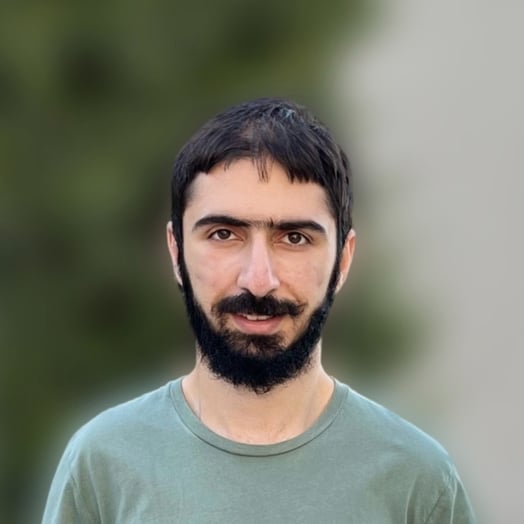
Erik Harutyunyan
Verified Expert in Engineering
Artificial Intelligence (AI) Developer
Erik is a master's student at the Technical University of Munich, studying mathematics in data science. During his last job at SuperAnnotate, he worked on various complex assignments, including edge detection, semantic segmentation, object detection, active learning, knowledge distillation, filter pruning, and deployment on edge device projects.
Portfolio
Experience
Availability
Preferred Environment
Visual Studio Code (VS Code), Jupyter
The most amazing...
...thing I've developed is improving the speed of an edge detection model by around five times by continuous R&D in knowledge distillation and filter pruning.
Work Experience
Computer Vision Consultant
SuperAnnotate
- Advised and shared expertise with LiDAR point cloud data, guiding the development of the LiDAR annotation tool.
- Guided the video action recognition smart feature in the video editor tool.
- Led the real-time object tracking smart feature in the video editor tool.
- Proofread and commented on computer vision-related marketing articles and whitepapers.
Computer Vision Researcher
SuperAnnotate
- Used state-of-the-art uncertainty estimation methods to develop the priority score feature for the tool that suggests to the annotator which images to annotate first.
- Improved the speed of an edge detection model by around five times applying state-of-the-art knowledge distillation and channel pruning methods, with only losing 1% in the F1 score.
- Researched and developed an improvement for the smart segmentation algorithm that lies in the core of the SuperAnnotate.
Machine Learning Engineer
SuperAnnotate
- Employed OpenVINO and TensorRT to develop an integration covering from uploading raw data to the platform to training and subsequent deployment of object detection models to OAK-D and Jetson Nano devices, respectively.
- Developed analytics and visualization functions for the SDK to give insights into raw data and its annotations.
- Wrote medium articles and whitepapers about the cutting-edge projects done in SuperAnnotate.
Data Scientist
Ucom
- Created an anomaly detection system using classical time series forecasting methods to predict the going down of internet spreading towers. The system helped to decrease the towers' downtime by four times on average.
- Developed tabular customer data of the company to predict the churn of each customer. The model reached around 85% accuracy when deployed in production.
- Used customer service usage data to provide a trustworthiness score that the company decided whether to sell mobile phones with monthly payments or demand the full price at once.
Experience
Active Learning for 3D Semantic Segmentation
https://github.com/ero1311/Pointnet2.ScanNetConsensus-based Optimization for Convolutional Neural Network
https://github.com/ero1311/cbo_implemenationsAnalytics Functions for SuperAnnotate Python SDK
https://github.com/superannotateai/superannotate-python-sdkFUNCTIONS INCLUDE:
• Consensus and benchmark that score annotators or groups of annotators on a small subset from the dataset to help the user select the ones whom they want to assign the labeling project.
• Embedding functions that produce 2D scatter plots for the dataset to give insights into the similarities and clusters present in the dataset.
• Annotation statistics and visualizations that include bar charts of classes, subclasses, attributes in the annotations, annotation times and counts for individual annotators, etc.
From Raw Data to Model Deployment Pipelines
https://github.com/superannotateai/model-deployment-tutorials• Loading raw data to the SuperAnnotate platform
• Training a state-of-the-art model with annotated data
• Deploying the trained model to the edge device
Education
Master's Degree in Mathematics in Data Science
The Technical University of Munich - Munich, Germany
Bachelor's Degree in Computer Science
The American University of Armenia - Yerevan, Armenia
Skills
Languages
Python 3, Python, SQL, R, C++
Libraries/APIs
PyTorch, OpenCV, NumPy, Scikit-learn, Pandas, SciPy, TensorFlow, PySpark
Tools
TensorBoard, Jupyter, Plotly, MATLAB, OpenVINO, Amazon SageMaker, ERDAS
Paradigms
Data Science
Platforms
Visual Studio Code (VS Code), Amazon Web Services (AWS)
Storage
Google Cloud
Other
Machine Learning, Computer Vision, Deep Learning, Optimization, Object Detection, Artificial Intelligence (AI), Generative Adversarial Networks (GANs), Image Generation, Active Learning, Probabilistic Graphical Models, Probability Theory, Statistics, Generalized Linear Model (GLM), Bayesian Statistics, Classification, Dimensionality Reduction, Clustering, Deployment, Semantic Segmentation, Build Automation, Big Data, Data Visualization, Big Data Architecture, Computer Vision Algorithms, Image Processing, Object Tracking, Machine Learning Operations (MLOps), Deep Neural Networks, Neural Networks, Datasets, Algorithms, Data Structures, OOP Designs, Mathematics, 3D, 3D Pose Estimation, Dash, NVIDIA TensorRT, GPT-2, Reinforcement Learning, Generative Models, Natural Language Processing (NLP), GPT, Generative Pre-trained Transformers (GPT), LiDAR
How to Work with Toptal
Toptal matches you directly with global industry experts from our network in hours—not weeks or months.
Share your needs
Choose your talent
Start your risk-free talent trial
Top talent is in high demand.
Start hiring